skip to main |
skip to sidebar
Events of Saturday, 30th September 2017
After a pleasant interlude in the 'Emirates' lounge at Birmingham (described here) we boarded the huge A380 right time. They offered a very decent lunch about an hour into the seven-hour journey and the entertainment system worked correctly, although I think a degree in Information Technology is really necessary to master the intricacies. Well, I watched 'Wonder Woman' and 'Churchill', both interesting in different ways and found time to see the first episode of the television serial 'The Bridge' (which I'd somehow managed to miss when it was on terrestrial television). The combined effect of our aircraft heading east at Mach 0.93 and the earth rotating away from us [not, as I first wrote when tired, towards us] at around one revolution per day meant that our 7 hour journey appeared to have taken over ten hours as we'd moved through various Time Zones. A journey like this does rather convince you that the Earth is round (oh, alright, it's more an 'oblate spheroid').
We'd entered Dubai Terminal B using Air Bridges so we left the air conditioned cocoon of the A380 for the air-conditioned comfort of the terminal without sampling the desert heat outside. After some searching, I worked out that my flight onwards from Dubai to Yangon on EK.388 left from Terminal A. This meant descending to a subterranean level in one of a number of over-sized lifts and catching the next rubber-tyred, driverless train which transferred me to Terminal A with a choice of lifts or escalators to get to the departure level and the inevitable security re-check.
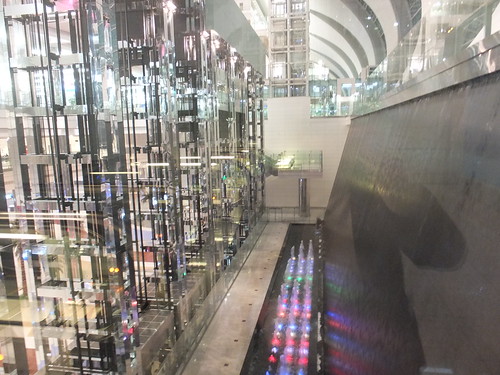
Dubai Airport: Left: Bank of over-size lifts, right: Impressive 'wall of water' feature.
I still had a walk of around 15 minutes to reach the gate where the crush of passengers seemed to be creating some problems in the smooth boarding of the aircraft. But the harrassed staff remained friendly so, after a delay, I boarded one of a number of transfer buses which were to take us to the remote Boeing 777. That journey took around 20 minutes, following a convoluted route around the perimeter of the airport, occasionally pausing for permission to cross various taxiways. By the time I was seated, I was exhausted from the sheer effort of transferring from one flight to another. We had a wait of over an hour whilst more of our passengers made the same tortuous journey to the aircraft and then whilst Air Traffic Control found a 'slot' for our departure in the apparently continuous stream of flights leaving Dubai. The cabin crew did a splendid job of keeping everybody happy during the wait. A lunch was served during 5-hour flight to Yangon but I wasn't very hungry, although I did manage to watch more episodes of 'The Bridge'. I'm afraid the entertainment system would occasionally execute an undemanded function (electrical noise, I assumed). I noticed that my seat position wasn't the only one so effected.
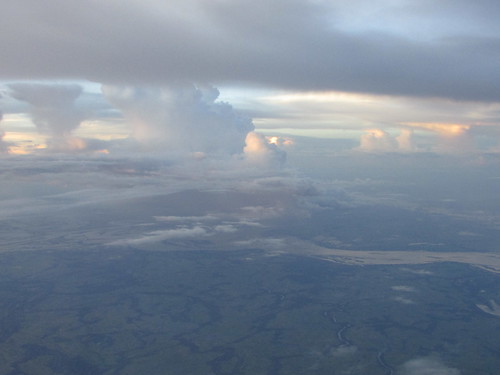
Burma from Above 30-Sep-2017: Approaching Yangon as the sun sets.
Our late departure from Dubai was reflected in a late arrival at Mingalardon Airport, Yangon where it was already dark. Unfortunately, the delays in Immigration were longer than I've previously experienced at Yangon. Despite the extra time this gave the baggage handlers to offload the luggage, having successfully negotiated Immigration, I was then faced with a worrying wait until, at last, my checked bag appeared on the conveyor.
Customs was quick and friendly (they X-ray hand baggage but not hold bags) and I was relieved to see my name being held up by my driver in the Arrivals Hall. I'm fraid that, matching the minor difficulties I'd experienced throughout, the journey to the 'Sule Shangri-La Hotel' (which was still the more evocative-sounding 'Traders Hotel' the last time I had a room there) took well over an hour.
I wasn't unhappy with the day - just very tired. I still find it almost incredible that such a journey is possible so quickly. In the days of sailing ships, it could take weeks, if not months, to achieve the same and in significantly less comfort than I had enjoyed.
Related posts on this website
This is one of a series of posts describing my 12th visit to Myanmar. The post Starting out is the first post in the series.
Clicking on the 'Next report' link displays the post describing the next events. In this way, you may read about the trip in sequence.
Next report on this trip.
Alternately, clicking on the 'All my Burma-2017(2) reports' link displays all the posts on this trip in reverse date-of-posting order.
All my Burma-2017(2) reports.
My photograph albums
Where necessary, clicking on an image above will display an 'uncropped' view or, alternately, pictures from may be selected, viewed or downloaded, in various sizes, from the albums listed:-
Dubai Airport, U.A.E..
Burma from Above.
Yangon Airport.
Sule Shangri-La Hotel, Yangon.
Events of Friday, 29th September 2017
I'm starting out on another long-distance trip and, once again, the destination is Myanmar (as Burma is now called). When I travelled to Burma for the first time, back in 2008, I little realised the spell this country, and its remarkable people, would weave, resulting in my returning time after time.
That first visit to Burma was part of a breathless, round-the-world affair described in a series of posts here and I've discussed my curious reaction to Myanmar in the post Myanmar, Serendipity and Jan.
This journey just starting will form my twelfth visit to Burma. Apart from now having a number of firm friends in Burma, I find it a most fascinating country, different in so many ways from my own country. Very slowly, I am finding out a little more about the place although, as I commented in the post Myanmar, Railways and Jan when talking about the limited research I'm attempting about the railway system in Burma, "In Myanmar, there always seem to be more questions than answers".
Although I love exploring different places, the process of travelling to them can become a little tedious. On the afternoon of my departure from home the sky was blue and the sun shone bravely, making it harder to tear myself away when the car arrived to pick me up at 5.30 p.m.
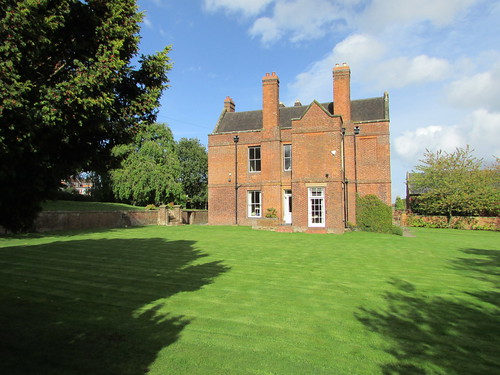
Brewood Hall Garden on 29th September.
So, I find myself writing this in the agreeable 'Emirates' lounge at Birmingham Airport at 8.30 p.m. whilst waiting to board flight EK.038 to Dubai.
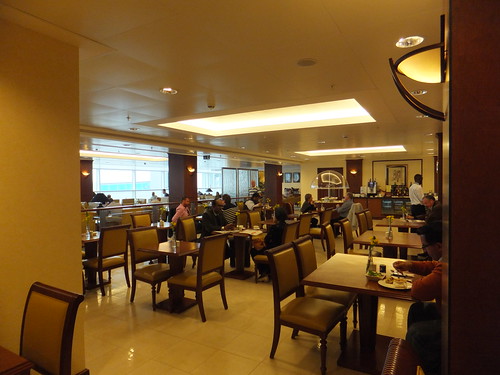
Birmingham Airport: The Emirates Lounge.
This flight is to be operated by an Airbus A380 (Wikipedia has an article here) and Emirates now have 100 of these monsters. I'm afraid I'm not a great fan of the aircraft, despite its impressive technical credentials. My flight onwards from Dubai to Yangon on EK.388 should be handled by a Boeing 777.
Related posts on this website
Next report on this trip.
All my Burma-2017(2) posts.
My photograph albums
Where necessary, clicking on an image above will display an 'uncropped' view or, alternately, pictures from may be selected, viewed or downloaded, in various sizes, from the albums listed:-
Brewood Hall Garden 2017.
Birmingham Airport, England.
In a post here, I talked about the locomotive designer Dugald Drummond and the genesis of his 'T9' 4-4-0, introduced in 1899, for the London and South Western Railway. Brought up in the Midlands in the time of post-war Nationalised railways, the former Southern Railway was very much a 'foreign railway' to me, as were its constituent railways, including the London and South Western Railway. I've written a short post about the London and South Western Railway here and the railway's important London terminus, Waterloo, is described here.
The 'T9' were nicknamed "Greyhounds" for their speed and free running. They had a long life, albeit with various modifications and, when the last of the class was withdrawn in 1963, it became part of the National Collection managed by National Railway Museum.
I'd always admired the class and when I had an invitation, around 1990, to visit Swanage to drive the preserved locomotive (then in LSWR livery and carrying the original number 120), I leapt at the chance. Sadly, when I arrived at Swanage I found out the engine had been 'stopped' for a hot axlebox on the 8-wheel tender. I still got my couple of days driving there but on the Johnson 'Half-Cab' 0-6-0 side tank, which I found a charming locomotive and surprisingly powerful.
Many years later, in 2013, the 'T9' visited the Battlefield Line. This time, it was British Railways lined black 'mixed traffic' livery and sporting the number 30120 which corresponded better with its modified appearance with extended smokebox and stovepipe chimney. Sadly, I wasn't rostered on the 'T9' during its visit but working on the diminuitive Beattie Well Tank alternating departures with the 'T9' was a special experience (described in the post here).
The 'T9' returned to Shackerstone for the 2015 'Santa' trains, alternating departures with 'Austerity' tank 'Cumbria'. Although I was originally rostered on the 'T9' on two of the 'Santa' days, they both were swopped to the 'Austerity' as described here. The 'T9' remained at the Battlefield Line for the start of the 2017 season but when my booked turn on the 'T9' in March was cancelled, I began to think that I was fated never to team-up with Drummond's classic.
However, on Saturday 8th April 2017, I finally got to drive 30120 at the Battlefield Line with Adrian L. acting as fireman and Graham L. cleaner.

Drummond 'T9': 30120 during preparation on 8th April 2017.
I had a second turn on Easter Sunday, 16th April 2017, this time with Jamie W. as fireman. My brief assessment of the locomotive? "Proper Job".

Drummond 'T9': 30120 during preparation on 16th April 2017.
Preparing the 'T9'
When the modernisation of British Railways in the 1950s introduced more complex diesel and electric traction, specific training of drivers and (where provided) secondmen for the different classes of motive power was regarded as essential. But earlier, in the steam era, once footplatemen were 'passed out', they were normally expected to sort out for themselves how to prepare, fire and drive whatever class of engine came along. Originally, I thought this must have been a daunting task but, over the years, I've learned to appreciate the challenge. Despite the variety of designs, the basic principles of steam locomotives have remained remarkably unchanged since the early days and intelligent observation, sometimes coupled with tips from other crews, can solve most queries. So, I enjoyed clambering over the 'T9' and finding out how Drummond had produced his 'masterpiece'.
During his time on Scottish railways, Drummond had learnt the value of rugged, reliable construction and the 'T9' fully embodied these principles. I was impressed by the 1-inch thick steel frames, the robust castings and forgings, the generous bearing areas and the overall simplicity of construction.
The Motion Plate supports the rear of the slide bars and must provide a rigid anchorage, as shown in the picture below. Stephenson Link motion was employed (the increasing popularity of Walschaert's motion in England came rather later). However, well-designed Link motion serves most needs and Drummond's arrangement was considered very successful. The picture below also shows the curved Expansion links which allow alteration of cut-off and direction of travel, in the case of the 'T9' under the control of steam reversing gear.
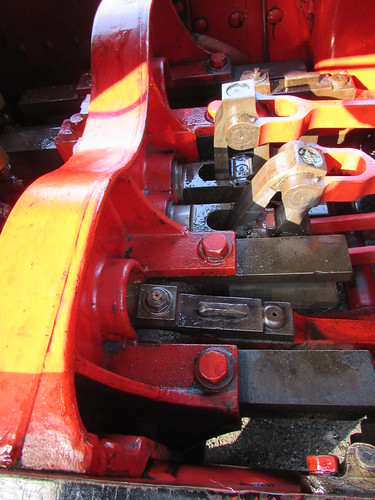
Drummond 'T9': View between frames from left side, showing rear of Motion Plate and Expansion Links.

Drummond 'T9': View between the frames, looking rearwards. L-R: Hornguide for right driving wheel, Right crank (on back dead centre), Four eccentric rods and eccentric sheaves, Left crank (on bottom quarter), Hornguide for left driving wheel.
I was impressed by the compact design of the two-cylinder steam reversing gear, with the cylinders mounted vertically in-line inside the left main frame, just ahead of the left driving axlebox.
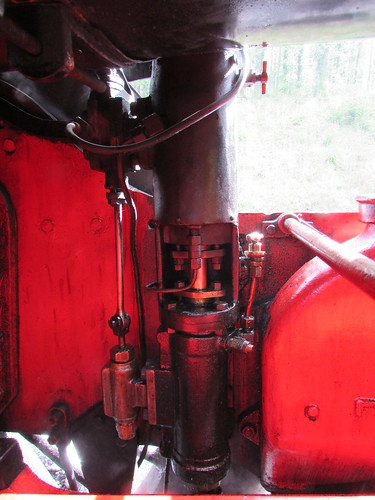
Drummond 'T9': Steam Reverser, mounted inside left main frame.
30120 has the earlier-pattern 'narrow' cab which could be described as 'cosy'. The splashers of the trailing coupled wheels protrude into the cab on both sides and these are extended rearwards to form small toolboxes with a wooden seat on top.

Drummond 'T9': 30120 has the earlier-pattern 'narrow' cab.
The Driver's duties
On most early steam locomotives, the driver's position was on the right of the footplate. Industrial locomotives were usually (but not invariably) right-hand drive. The Great Western Railway stayed with right-hand drive to the end (and beyond - prior to Nationalisation in 1948, the Great Western Railway placed an order with private contractors for 200 of the '94XX' class 'Pannier' tank, leaving British Railways to pick up the bill, as I mention in the article here).
But, on double-track railways in Britain, we drive 'on the left' and, as a consequence, the most convenient position for signals is further to the left. Generally, the driver will have a better view of signals on the left of the track if he is on the left of the footplate. Over time, modern locomotives in Britain became left-hand drive. Some had originally been right-hand drive and were rebuilt as left-hand drive. The iconic 'Flying Scotsman', proudly exhibited at the British Empire Exhibition in 1924, was built as right hand drive, as you can see from the drawing in the article 'Flying Scotsman'. 'Flying Scotsman' had been rebuilt with left-hand drive many years before I first got my hands on her at Birmingham Railway Museum in 1992 (described here).
The 'T9' is left-hand drive so the main driving controls are on the left of the cab - Reverser, Regulator and Vacuum Brake.
Reverser
Steam-operated power reversing gear is fitted, controlled by a short lever painted red which stands vertical except when changes to setting are required.
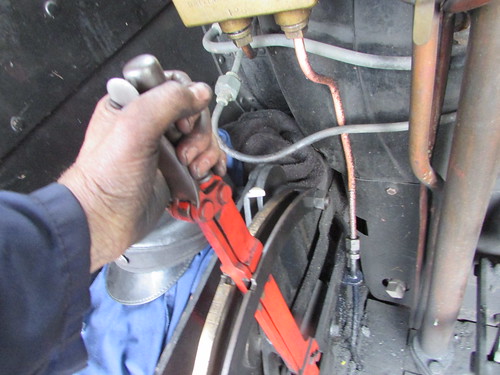
Cab Reversing Lever being placed in 'neutral', having just 'Linked-Up' the gear in 'Forward' to the position indicated by the white-painted pointer which moves over the engraved, brass cut-off indicator scale.
I'm afraid I found a tendency for the gear to 'creep' towards full gear when travelling forwards but reverse gear was better-behaved.
Regulator
The regulator is closed in the 'seven o'clock' position. It is progressively opened 'underarm' as the lever is pushed towards 'four o'clock' (the only other engine I can remember driving with an 'underarm' regulator was the 'B12', which was right hand drive - this is mentioned in the post Locomotive Regulators (part 2)).
Vacuum Brake
A combined fitting provides small ejector, large ejector, driver's brake application valve, vacuum relief valve and release valve together with a horizontally mounted handwheel on the shut-off cock. Vacuum brake cylinders are provided on both locomotive and tender. The tender brakes can also be applied from a handwheel.
Blower Valve
The Blower Valve Handwheel is tucked in the front left corner of the cab, only accessible to the driver. More modern practice favours a position accessible to both driver and fireman. The actual blower valve is located adjacent to the smokebox, operated by a rod passing through the left handrail.
The Fireman's duties
As commented above, early steam locomotives tended to be right-hand drive, meaning the fireman normally worked from the left side of the footplate, favouring right-handed firing. But on the 'T9' and many other designs (later LMS, LNER, SR and BR locomotives) the fireman is on the right, favouring left handed firing. Some fireman were happy either way round, others permanently grumbled if forced to fire the 'wrong' way. Drivers could get bad-tempered if they felt that their fireman was 'invading their space' and there are many tales of drivers drawing a chalk line down the middle of the footplate - I recount one of these in the post A Day on the Footplate (2).
There's a (still incomplete) introduction to firing steam locomotives at MIC - Firing Steam Locomotives (1).
The position of the coal supply in the bunker or tender also varies between designs, sometimes being delivered at footplate level, requiring the fireman to bend, sometimes appearing at a raised shovelling plate (often called the "married men's tender").

Drummond 'T9': Watercart tender, showing raised shovelling plate, tender handbrake and large toolbox.
The coal then has to be fed through the firehole which, according to locomotive class, varies in shape, size and height above the footplate and can be equipped with different patterns of firedoor requiring some adaptability on the part of the fireman. The 'T9'has a top-hung, inward-hinging cast firedoor which can be held open at various angles by the use of a ratchet, controlling the amount of 'secondary' or 'top' air admitted to the firebox. The top-hinging means that a separate Baffle Plate is not required - when open, the door acts its own baffle. This design was quite widely used in this country (certainly by the L.N.W.R and Lancashire and Yorkshire Railway) and also overseas. The cast door can be a little heavy to work frequently but a hinging half-flap is provided which, when raised, may allow the firedoor to remain open.
Great Western firemen became adept at winding the chain from a similar flap-plate around the operating handle of the main, sliding firedoors. A 'pull' on the chain would then 'flip' the flap-plate open or shut with very little effort, leaving the main firedoors open. If the steaming rate demanded was not too high, they would leave the flap-plate shut and fire 'over the top', which required accurate shovel-work.
Stanier engines for the L.M.S. had a similar flap-plate, allowing a similar technique to be adopted.
The Great Northern Railway (later the L.N.E.R.) used a 'Trap-Door' design of firedoor, very convenient in use, once the technique was mastered. There's an introduction to this firedoor in the article Firing a 'B1'.
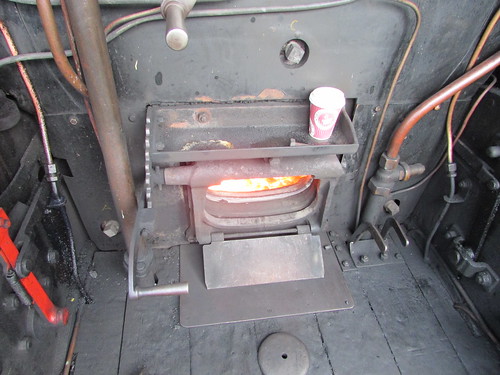
Drummond 'T9': Firehole with top-hung, inward-hinging firedoor. Note Flap Plate.
Different designs of firebox then require different firing techniques to produce steam economically. The 'T9' has a reasonably long 'box', almost 7 feet long front to back inside (nowhere near the length of, say, a Great Western 'King') with a sloping grate. If the fireman is lucky, when 'on the road', he can feed coal to the back the firebox (nearest the footplate) and the motion of the engine will trickle it forward to the front.
The 'T9' Tender
The preserved 'T9' has the distinctive 8-wheel 'Watercart' tender, giving a coal capacity of 5 tons and a water capacity of 4,000 gallons. Unusually, the two 4-wheel bogies are provided with inside axleboxes. Although tenders carried on eight wheels are very common overseas, I can only recall designs with outside axleboxes. A locomotive depends upon its supply of water as discussed in the post Water, water, everywhere. This was particularly important for the L.S.W.R. (later Southern) lines as they stretched far west into the territory of the Great Western Railway but, alone amongst major British railways, no water troughs were ever installed. On the West of England services, changing engines was frequently undertaken at Salisbury and, of course, water was available at major stations and yards.

Drummond 'T9': The 8-wheel 'Watercart' tender is provided with inside axleboxes.
Passage of Water from Tender to Boiler
Water from the tender is fed by gravity via two water cocks set in the wooden floor of the cab to two live steam injectors, one on either side of the firebox.
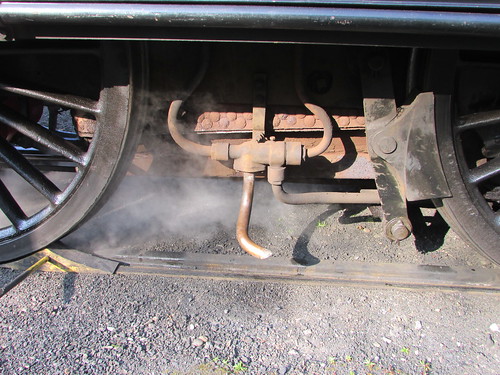
Drummond 'T9': Driver's side Live Steam Injector, suspended on a simple bracket alongside the firebox. The connections are (L-R): Delivery to boiler, Overflow, Cold water, Steam.
The injector uses steam from the boiler to pressurise the water to greater than boiler pressure (a feat of apparent magic possible due to the work of mathematician Bernoulli and engineer Henri de Giffard), allowing the water to feed the boiler through a one-way valve called a Clack Valve (there's a little more about the Clack Valve in a post here). In this way, water boiled into steam and converted into motion in the cylinders could be replenished. The steam for the injectors is taken from the top of the firebox and controlled from the cab by the Injector Steam Valves.
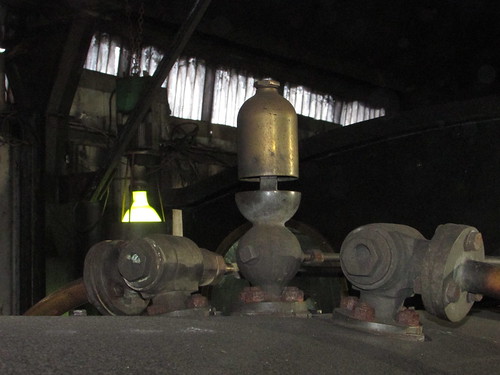
Drummond 'T9': View showing top of firebox with whistle and, left and right, Injector Steam Valves controlled by long rods extending to handwheels in the cab.
The pressurised water from the injectors is fed into the boiler via clack valves on the horizontal centre line of the front ring of the boiler shell on both sides. This was the 'classic' position for introducing feed water into locomotive boilers until the advantages of 'top feed' were understood in the 20th century.
 Drummond 'T9': 30120 being prepared at Shackerstone, showing the position of the Driver's Side Clack on the 'front ring' of the boiler shell.
Drummond 'T9': 30120 being prepared at Shackerstone, showing the position of the Driver's Side Clack on the 'front ring' of the boiler shell.
Related posts on other sites
Brief data on 30120 and 'T9' (Rail UK Site).
Related posts on this site
Dugald Drummond and the 'T9' - Historical Background.
My Pictures
Where necessary, clicking on an image above will display an 'uncropped' view or, alternately, pictures may be selected, viewed or downloaded, in various sizes, from the album listed:-
Drummond 'T9'.
On Sunday 20th August 2017, I was driver at the Battlefield Line, once again on 'Cumbria', an 'Austerity' tank locomotive. You might imagine that regularly driving on the same line would lead to boredom, but no two days are the same and this one certainly didn't turn out as planned.
There was a 'Gold' footplate experience course booked so I signed on at 06:30. Our lady fireman, Tracey, was 'booked fireman' but on that day she was observing our trainee, Ritchie, with a view to his becoming a 'Passed Cleaner' which would enable him to act as a fireman in his own right in the future. When I arrived Tracey and Ritchie had already done the initial checks and lit-up, so I set-to oiling and examining the locomotive.
An intimation of the problem to come was quickly revealed as I found the left leading spring with a broken 'leaf' near the buckle and the rear portion of the leaf was working its way out of the buckle.
In steam locomotive design, the weight of the engine is transferred to the wheels via springs connected to axleboxes arranged to slide up and down in hornguides attached to the main frames. Some vertical movement of the axlebox is possible as the spring deflects from its 'rest' position', but the tension in the spring then acts as a restoring force to return the axlebox to its 'rest' position. Each 'wheelset' (an axle with two wheels) has two axleboxes embracing two machined areas on the axle (the journals) so that each wheel has 'independent suspension' allowing it to rise and fall, following 'bumps' in the track.
Various types of spring are used but the laminated leaf spring, as used on the 'Austerity' tank, is most common. Two arrangements are possible with laminated springs, depending upon whether the spring is mounted above or below the associated axlebox. The 'Austerity' tank is 'undersprung' where each end of the spring is connected, via links which allow the spring to 'flex', to the main frames and the buckle in the middle of the spring is connected to the bottom of the axlebox.

'Austerity' Elevation showing 'undersprung' laminated springs on each axle (Industrial Railway Record).
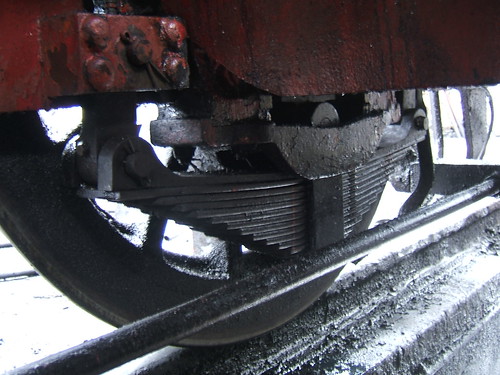
This picture shows the (undamaged) spring on the left leading axlebox of 'Austerity' tank 'Royal Pioneer'. The long, round horizontal rod across the foreground is part of the brake rigging.
There were no maintenance staff on duty at Shackerstone and, even if there had been, jacking-up the engine and changing a main spring would have made us very late into traffic, jeopardising both the footplate experience course and the advertised service. Resident Peckett locomotive 'Sir Gomer' was standing next in line in the shed but completely cold. I didn't even consider using 'Sir Gomer' because, even if fit for traffic, the time to bring the cold locomotive into steam would have meant no trains until the afternoon.
In the days of steam on post-war railways various techniques were adopted in emergency to reduce the time it took to make an engine steam but the more 'agressive' techniques tended to reduce boiler life and increase maintenance costs. The coefficient of expansion of metals means that when a boiler is brought to working temperature, the dimensions increase. If this is done too quickly, the stresses on rivets, stays and boiler tubes may result in leaks. I think I worked out that the boiler on a Great Western 'Castle', for example, becomes about half an inch longer when hot (and the design allows the firebox to slide on supports to accommodate this expansion). Some sheds kept a flexible hose attached to a long hooked pipe. The hooked pipe was lowered into the chimney of the engine to be steamed and the hose was attached to another engine already in steam. Allowing steam to flow through the pipe and escape from the chimney provided a draught to 'encourage' steaming in the way that the Blower stimulates the fire on an engine already in steam. Another approach was to couple the engine to be steamed to a second locomotive and drag it up and down the yard with the reverser of the engine to be steamed set in the 'wrong' direction. The cylinders acted as air pumps, pressurising the boiler with compressed air. When the Blower Valve was opened, the escaping compressed air provided a draught to the fire (at least briefly).
As an alternative, I found a large sledge hammer and, as carefully as I could, hammered the protruding section of the broken spring leaf back towards its original position. In the limited time available, that was as much as I could do and I decided that I would take the locomotive into traffic and keep my eye on it during the day.
Our driver on the 'Gold Experience' course arrived early and we set off light engine for Shenton, with me explaining the use of the driving controls and the need to comply with the various speed restrictions along the line. We returned to Shackerstone and coupled onto the waiting train. By this time, our 'Gold' driver's family had arrived and they boarded the train as I introduced the complications of the vacuum brake which we'd be using on this trip. We made and uneventful trip to Shenton, uncoupled and 'ran round' then returned to Shackerstone. Our 'Gold' driver had performed well and had clearly had a most enjoyable time. We all said 'good bye', uncoupled, ran round, watered and prepared to take the 11.15 a.m. train which departed a few minutes late.

'Cumbria' ready to leave Shackerstone on an earlier date.
We completed three of the five 'booked' round trips but, by this time, the broken spring leaf had worked its way back out a few inches and my attempts to persuade it to return nearer to its correct position were not successful. Not wanting to risk a complete failure down the line (with the risk of 'stranding' passengers) I decided to 'fail' the locomotive. We believed the Diesel Multiple Unit (DMU) was serviceable so it was agreed that Ritchie would go and start-up the DMU whilst Tracey and I limped onto shed and disposed of the steam locomotive.
I need to introduce a little background here. I have described my previous turn on the DMU on Wednesday 2nd August 2017 in the post Summer at Shackerstone when we were using the 2-car set (51131/51321). After that turn, Ritchie took 51321 out of service for repairs to the roof so subsequent services had operated with 51131 coupled to the single-unit 'Bubble Car' 55005. The versatility of the Electro-Pneumatic control systems allows this sort of unconventional arrangement. However, I learnt that, subsequently, one of the two engines on 55005 had failed and there had been some difficulty in isolating the failed engine.
Like many cars, a Diesel Multiple unit requires a gearbox to match the limited range of engine speed over which an internal combustion engine can provide reasonable torque with the wide range of vehicle speed required. Many of the British Railways designs (and all the examples at Shackerstone) use an Electro-Pneumatically controlled (E.P.) epicyclic gearbox. Unlike cars, a Diesel Multiple unit travels as far travelling backwards as forwards and needs a range of gears in both directions. So, instead of making 'reverse' an 'add-on' to a gearbox, it is made a separate function, called the Final Drive, mounted on the driven axle and also E.P. controlled. The engine always rotates in the same direction and the drive, having passed through the gearbox, turns a Cardan Shaft, again always the same direction. The reversal occurs within the Final Drive unit by operating a selection 'Dog' splined into the input shaft from the gearbox but free to slide so as to engage one of two bevel gears which, via a spur gear, determine the direction in which the axle revolves. The sliding 'Dog' is actuated by a Selector Fork controlled by two E.P. valves.
To take an engine out of service the Starter Motor is electrically isolated by operating an underframe-mounted switch adjacent to the engine.
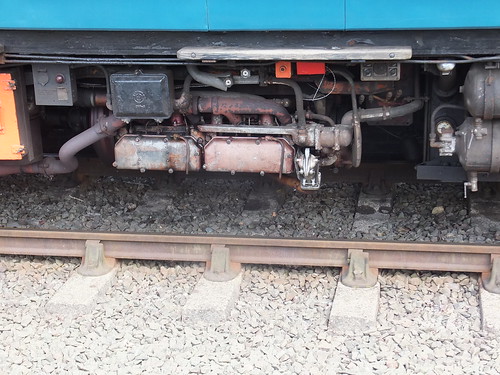
55005 Number 2 Engine: The Engine Isolator Switch is the orange-painted square box underneath the wooden footstep.
A failed engine must also be mechanically isolated from the wheels by latching the 'Dog' Selector Fork in a central, 'neutral' position. This is achieved by pulling-out and turning an Isolating Plunger mounted on top of the final drive. A spring then pushes the Isolating Plunger so as to engage in a groove when the Selector Fork and 'Dog' are in the 'neutral' position, confirmed by rotating the Cardan Shaft by hand. The Isolating Plunger is in an inaccessible position almost on the centre line of the vehicle so the Guard's Compartment is equipped with a special long-handled fork (always called the 'Toasting Fork') to assist.
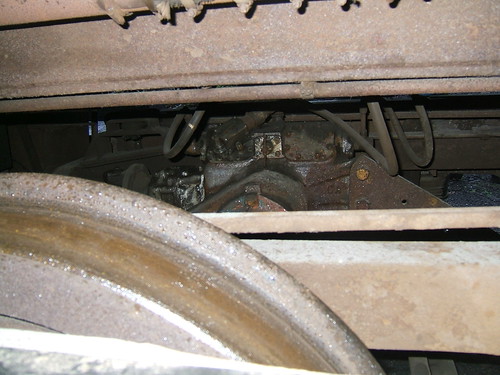 DMU Final Drive: The small rectangular casting near the centre of the picture is the Isolating Plunger. Pulling and turning the bar into the horizontal position isolates the drive.
DMU Final Drive: The small rectangular casting near the centre of the picture is the Isolating Plunger. Pulling and turning the bar into the horizontal position isolates the drive.
My post Diesel Multiple Units has links to training material produced by British Railways: black and white sound films and training notes.
Ritchie completed the fourth round trip with the 2-coach train running on three engines. With an engine 'out', performance is affected but Ritchie found the operation unexpectedly sluggish. By the time he returned to Shackerstone, Tracey and I had completed disposal of the steam locomotive so Ritchie invited me to drive the last train. However, as soon as I started away, I agreed with Ritchie that the unit seemed very 'unhappy'. Having gone barely 300 yards, Ritchie decided that we should cancel the run. We never like to disappoint passengers but, with the risk of failing 'in the section', I readily agreed, 'changed ends' and slowly drove back to the platform to disembark our passengers. Having 'changed ends' again, I then very slowly drove to the DMU siding and Ritchie (who, of course, owns the diesel multiple units at Shackerstone) immediately set-to dismantling the Final Drive and, before long, discovered that the 'Dog' (described above) had shattered, suggesting that permanent isolation might not have been achieved. He removed the broken pieces and decided to remove the Cardan shaft so that the midweek railcar service could continue whilst he arranged the necessary repairs.
What happened next?
I was rostered as driver on 'Cumbria' a week later, Sunday 27th August 2017) and, again, there was a 'Gold' footplate experience course followed by five passenger trips to Shenton and back. Temporary repairs had been made to the spring (tack welding and clamping) and no problems were encountered. I was delighted to be 'paired' with Ritchie, now a Passed Cleaner on his 'maiden' solo firing turn. We both had a very enjoyable day.
I was re-united with the DMU for a 'Midweeek' turn on Wednesday 13th September 2017 with Grant as Guard. The initial problem we faced was that the 2-coach DMU (51131 with both engine serviceable coupled to 55005 with one engine in use) had been 'boxed-in' by a class '04' shunter and a freight wagon. There was no passed '04' driver on site but I was happy to use the DMU to push the vehicles down the 'North End', out of our way. I brought the DMU onto the wagon and coupled on, using the wagon's 'Instanter' coupling in the long position (there's more about the 'Instanter' here). But then we had to release the brakes on the '04'. Brakes on diesel shunters are normally 'co-acting' - they can either be applied by a proportional brake valve when an air receiver is 'charged' (from an engine-driven compressor) or, alternately, manually, (usually from a handbrake wheel in the cab). Neither Grant nor I could budge the handbrake wheel on the '04'. It was clear that the brake had been applied using air and the handbrake wheel then turned to 'take up the slack', resulting in a brake application very difficult to release by hand. It took Grant and I some minutes (using a fishplate as a lever) to release the brake in small steps. Then, with Grant keeping a lookout from the cab of the '04', I propelled the unwanted vehicles out of the way. We re-applied the '04' brake (by hand!), I uncoupled and shunted back to the station with waiting passengers curious about our antics. I think we were seven minutes late with the first departure but, even with one engine out of use, had no difficulty keeping to time for the rest of the day. Grant and I agreed that we'd had a very pleasant day.
Related posts on this website
The 'Austerity' 0-6-0ST locomotive.
To see all my posts about Diesel Multiple Units, select Label 'DMU' or click here.
To see all my posts about the Battlefield Line, select Label 'Battlefield Line' or click here.
My photograph albums
Where necessary, clicking on an image above will display an 'uncropped' view or, alternately, pictures from may be selected, viewed or downloaded, in various sizes, from the albums listed:-
'Cumbria'.
Royal Pioneer (Up close & personal) [Pictures of another 'Austerity' tank].
All my Battlefield Line albums.






















